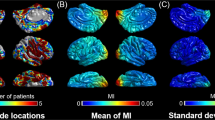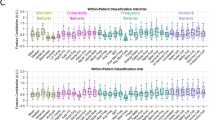Abstract
For many patients who are candidates for epilepsy surgery, non-invasive evaluation fails to provide sufficient information to permit surgical treatment. Since there are also definite risks and considerable costs associated with invasive procedures, new (non-invasive) techniques are required. This study provides empirical evidence that a non-linear approach applied to ictal surface electroencephalograms (EEGs) can help to delineate the area of seizure onset and may prove useful in complementing visual analysis of the EEG. Multichannel EEGs, recorded from eight patients with different drug-resistant localisation-related epilepsies, were analysed using the concept of correlation dimension and two extensions based on the pointwise dimension. The latter also provided results in cases where assessment of the correlation dimension was not feasible. Comparative values between 2 and 6 were accepted as the result of the algorithms, mostly 3–4 for the EEG channels strongly reflecting epileptic activity, and 4–6 for the other signals. The proportion of accepted pointwise values was usually 200–800% for strong epileptic EEG activity compared to the other data. The approach permitted the characterisation of the scalp area reflecting epileptic activity. The results obtained were in perfect concordance with those obtained during pre-surgical work-up and confirmed by the post-operative outcome.
Similar content being viewed by others
References
Argyris, J., Faust, G. andHaase, M. (1994): ‘An exploration of chaos’ (Amsterdam: Elsevier Science B.V., North Holland)
Albano, A.M., Muench, J., Schwartz, C., Mees, A.I. andRapp, P.E. (1988): ‘Singular-value decomposition and the Grassberger-Procaccia algorithm’,Phys. Rev. A,38(2), pp. 3017–3026
Blanco, S., Figliola A., Kochen S. andRosso O.A. (1997): ‘Using non-linear dynamic metric tools for characterizing brain structures’,IEEE Eng. Med. Biol., July/August, pp. 83–92
Bullmore, E.T., Brammer, M.J., Bourlon, P., Alarcon, G., Polkey, C.E., Elwes, R. andBinnie, C.D. (1994): ‘Fractal analysis of electroencephalographic signals intracerebrally recorded during 35 epileptic seizures: evaluation of a new method for synoptic visualisation of ictal events’,Electroenceph. Clin. Neurophysiol.,91, 337–345
Casdagli, M.C., Iasemidis, L.D., Sackellares, J., Roper, S.N., Gilmore, R.L. andSavit, R.S. (1996): ‘Characterizing non-linearity in invasive EEG recordings from temporal lobe epilepsy’,Physica D,99, pp. 381–399
Cerutti, S., Carrault, G., Cluitmans, P.J.M., Kinie, A., Lipping, T., Nikolaidis, N., Pitas, I. and Signorini, M. G. (1996): ‘Non-linear algorithms for processing biological signals’,Comput. Meth. Programs Biomed.,51, pp. 51–73
Chen, J.J., Tsai, J.J., Sheu, C.H., Lin, H.Y. andYeh, J.G. (1997): ‘Application of dipole modeling in localization of mesio-temporal epileptogenic focus’,Proc. National Sci. Council Repub. China B,21(2), pp. 61–70
Engel, J. (Ed.) (1987): ‘Surgical treatment of the epilepsies’, (Raven Press: New York)
Farmer, J.D., Ott, E. andYorke, J.A. (1983): ‘The dimension of chaotic attractors’,Physica D,7, pp. 153–180
Feucht, M., Möller, U., Witte, H., Schmidt, K., Arnold, M., Benninger, F., Steinberger, K. andFriedrich, M.H. (1998): ‘Non-linear dynamics of 3 Hz spike-and-wave discharges recorded during typical absence seizures in children’,Cerebral Cortex,8(6), pp. 524–533
Frank, G. W., Lookman, T., Nerenberg, M. A., Essex, C., Lemieux, J. andBlume, W. (1990): ‘Chaotic time series analysis of epileptic seizures’,Physica D,46, pp. 427–438
Graf, K. E. andElbert, T. (1990): ‘Dimensional analysis of the waking EEG’ in Basar, E. (ed): ‘Chaos in brain function’ (Springer: Berlin) pp. 135–152
Grassberger, P. andProcaccia, I. (1983): ‘Measuring the strangeness of strange attractors’,Physica D,9, pp. 189–208
Heyden, M.J., Diks, C., Pijn, J.P. andVelis, D.N. (1996): ‘Time reversibility of intracranial human EEG recordings in mesial temporal lobe epilepsy’,Phys. Lett. A,216, pp. 283–288
Holzfuss, J. andMayer-Kress, G. (1986): ‘An approach to error-estimation in the application of dimension algorithms’ inMayer-Kress, G. (ed.): ‘Dimensions and entropies in chaotic systems’ Springer Series in Synergetics 32 (Springer: New York)
Jansen, B.H. (1996): ‘Non-linear dynamics and quantitative EEG analysis’,Electroenceph. Clin. Neurophysiol.Suppl.,45, 39–56
Koebbe, M. andMayer-Kress, G. (1992): ‘Use of recurrence plots in the analysis of time series data’, inCasdagli, M. andEubank, S. (eds.): ‘Non-linear modeling and forecasting’, SFI Studies in the Sciences of Complexity, Proc. Vol. XII, (Addison-Wesley), pp. 361–378
Krajca, V., Petránek, S. Patáková, I. andVärri, A. (1991): ‘Automatic identification of significant graphoelements in multichannel EEG recordings by adaptive segmentation and fuzzy clustering’,Int. J. Biomed. Comput.,28, pp. 71–89
Krajca, V., Petránek, S., Pietilä, T. andFrey, H. (1993): ‘“Wave-Finder”: a new system for an automatic processing of long-term EEG-recording’, inRother, M. andZwiener, U (Eds.), ‘Quantitative EEG analysis—clinical utility and new methods’ (Universitätsverlag: Jena)
Krystal, A.D., Zaidman, C., Greenside, H.S., Weiner, R.D. andCoffey, C.E. (1997): ‘The largest Lyapunov exponent of the EEG during ECT seizures as a measure of ECT seizure adequacy’,Electroenceph. Clin. Neurophysiol.,103, pp. 599–606
Lehnertz, K. andElger, C.E. (1995): ‘Spatio-temporal dynamics of the primary epileptogenetic area in temporal lobe epilepsy characterized by neuronal complexity loss’,Electroenceph. Clin. Neurophysiol.,95, pp. 108–117
Lehnertz, K. andElger, C.E. (1997): ‘Neuronal complexity loss in the temporal lobe epilepsy: effects of carbamazepine on the dynamics of the epileptic focus’,Electroenceph. Clin. Neurophysiol.,103, pp. 376–380
Lerner, D.E. (1996): ‘Monitoring changing dynamics with correlation integrals: Case study of an epileptic seizure’,Physica D,97, pp. 563–576
Lopes da Silva, F.H., Pijn, J.P. andWadman, W.J. (1994): ‘Dynamics of local neuronal networks: control parameters and state bifurcations in epileptogenesis’,Prog. Brain Res.,102, pp. 359–370
Manuca, R., Casdagli, M.C. andSavit, R.S. (1998): ‘Nonstationarity in epileptic EEG and implications for neural dynamics’,Math. Biosci.,147(1), pp. 1–22
Mars, N.J.I., Thompson, P.M. andWilkus, R.J. (1985): ‘Spread of epileptic seizure activity in humans’,Epilepsia,26, pp. 85–94
Pijn, J.P.M., van Neerven, J., Noest, A. andLopes da Silva, F.H. (1991): ‘Chaos or noise in EEG signals; dependence on state and brain site’,Electroenceph. Clin. Neurophysiol.,79, pp. 371–81
Pijn, J.P.M., Demetrios, N.V., v.d. Heyden, M.J., DeGoede, J., v. Jeelen, C.W.M. andLopes da Silva, F.H. (1997): ‘Nonlinear dynamics of epileptic seizures on basis of intracranial EEG recordings’,Brain Topography,9(4), pp. 249–270
Popivanov, D., Mineva, A. andDushanova, J. (1998): ‘Tracking EEG signal dynamics during mental tasks’,IEEE Eng. Med. Biol., March/April, pp. 89–95
Pritchard, W.S., Kriebel, K.K. andDuke, D.W. (1996): ‘On the validity of estimating EEG correlation dimensions from a spatial embedding’,Psychophysiol,33(5), pp. 362–368
Rapp, P.E., Albano, A.M., Guzmann, G.C., Greenbaum, N.N. andBashore, T.R. (1986): ‘Experimental studies of chaotic neural behaviour: Cellular activity and electroencephalographic signals’, inOthmar, H.G. (ed.): ‘Nonlinear oscillations in biology and chemistry’, Springer Lecture Notes Biomath, 66, pp. 175–197
Rapp, P.E., Zimmermann, I.D., Vining, E.P., Cohen, N., Albano, A.M. andJiménez-Montano, M.A. (1994): ‘The non-random structure of neural spike trains increases during focal seizures’,J. Neurosci.,14(8), pp. 4731–4739
Sarnthein, J., Abarbanel, H.D.I. andPockberger, H. (1997): ‘Non-linear analysis of epileptic activity in rabbit neocortex’,Biol. Cybern.,78, pp. 37–44.
Seri, S., Cerquiglini, A., Pisani, F., Michel, C.M., Marqui, R.D.P. andCuratolo, P. (1998): ‘Frontal lobe epilepsy associated with tuberous sclerosis: Electroencephalographic-magnetic resonance image fusioning’,J. Child Neurol.,13(1), pp. 33–38
Skinner, J.E., Carpeggiani, C., Landisman, C.E. andFulton, K.W. (1991): ‘Correlation dimension of heartbeat intervals is reduced in conscious pigs by myocardial iscemia’,Circ. Res.,68(4), pp. 966–976
Takens, F. (1980): ‘Detecting strange attractors in turbulence’, in Rand, D. A. and Young, L. S. (Eds.): Springer Lecture Notes Math 898, pp. 366–381
Theiler, J. (1986): ‘Spurious dimension from correlation algorithms applied to limited time-series data’,Phys. Rev. A,34(3), pp. 2427–2432
Theiler, T., Eubank, S., Longtin, A., Galdrikian, B. andFarmer, J.D. (1992): ‘Testing for non-linearity in time series: The method of surrogate data’,Physica D,58, pp. 77–94
Theiler, J. andRapp, P.E. (1996): ‘Re-examination of the evidence for low-dimensional, non-linear structure in the human electroencephalogram’,Electroenceph. Clin. Neurophysiol.,98, 213–222
Zaveri, H.P., Williams, W.J., Iasemidis, L.D. andSackellares, J.C. (1992): ‘Time-frequency representation of electrocorticograms in temporal lobe epilepsy’,IEEE Trans. Biomed. Eng.,39(5), pp. 502–509
Author information
Authors and Affiliations
Corresponding author
Rights and permissions
About this article
Cite this article
Feucht, M., Möller, U., Witte, H. et al. Application of correlation dimension and pointwise dimension for non-linear topographical analysis of focal onset seizures. Med. Biol. Eng. Comput. 37, 208–217 (1999). https://doi.org/10.1007/BF02513289
Received:
Accepted:
Issue Date:
DOI: https://doi.org/10.1007/BF02513289




